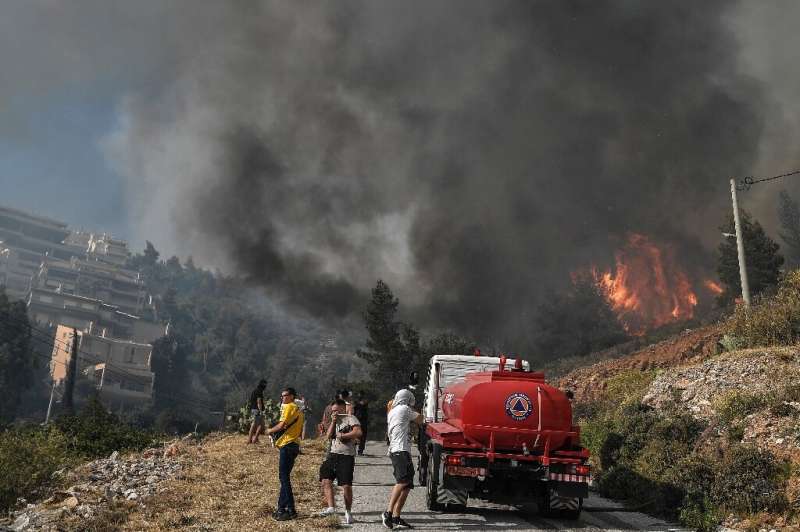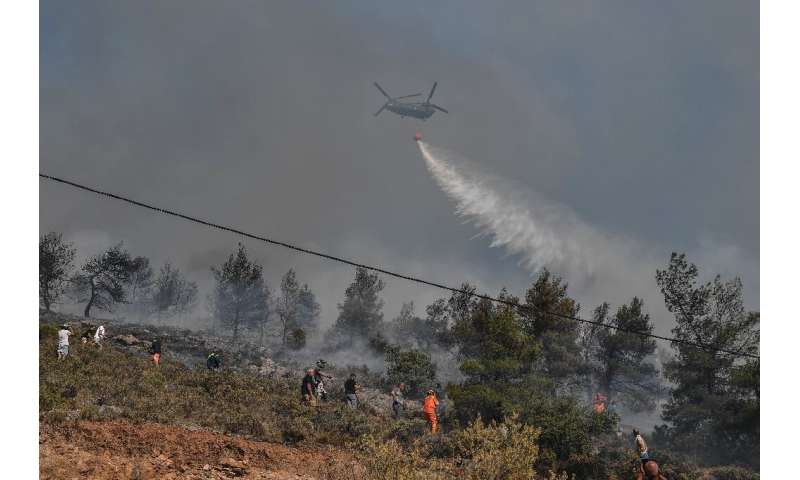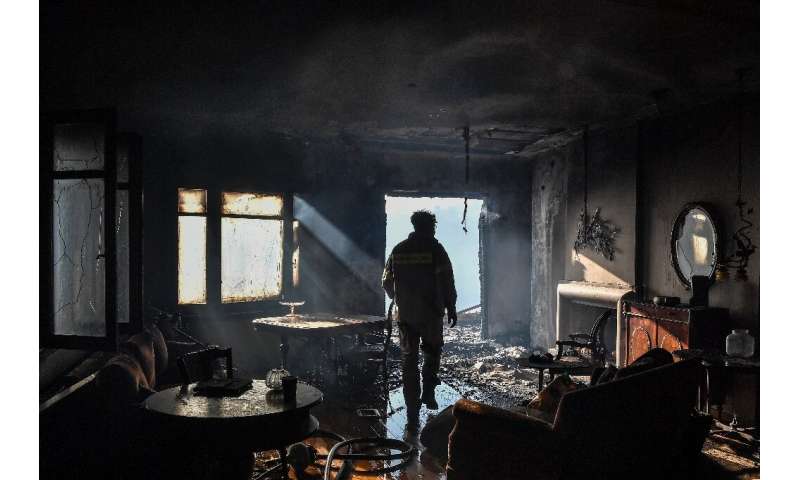Why Canada Races on Gun Policy When America Crawls
Max Fisher
Fri, June 3, 2022

Gun control advocates listen as Democratic senators speak at a rally at the Capitol in Washington, May 26, 2022. (Tom Brenner/The New York Times)
As Congress once more struggles through acrimonious and so far fruitless negotiations over gun reforms in the wake of a mass shooting, Americans may find themselves looking north in befuddlement.
Canada’s government has begun moving to ban handgun sales and buy back military-style rifles — dramatic changes in a country with one of the world’s highest gun ownership rates outside of the United States, expected to pass easily and with little fuss.
Ask Americans why Canada’s government seems to cut through issues that mire their own in bitterness and frustration, and you might hear them cite cultural differences, gentler politics, even easygoing Canadian temperaments.
But ask a political scientist, and you will get a more straightforward answer.
Differences in national culture and issues, while meaningful, do not on their own explain things. After all, Canada also has two parties that mostly dominate national politics, an urban-rural divide, deepening culture wars and a rising far-right. And guns have been a contentious issue there for decades, one long contested by activist groups.
Rather, much of the gap in how these two countries handle contentious policy questions comes down to something that can feel invisible amid day-to-day politicking but may be just as important as the issues themselves: the structures of their political systems.
Canada’s is a parliamentary system. Its head of government, Justin Trudeau, is elevated to that job by the legislature, of which he is also a member, and which his party, in collaboration with another, controls.
If Trudeau wants to pass a new law, he must merely ask his subordinates in his party and their allies to do it. There is no such thing as divided government and less cross-party horse-trading and legislative gridlock.
Canada is similar to what the United States would be if it had only a House of Representatives, whose speaker also oversaw federal agencies and foreign policy.
What the U.S. has instead is a system whose structure simultaneously requires cooperation across competing parties and discourages them from working together.
The result is a U.S. system that not only moves slower and passes fewer laws than those of parliamentary models like Canada’s, research has found, but also stalls for years even on measures that enjoy widespread support among voters in both parties, such as universal background checks for gun purchases.
Many political scientists argue that the United States’ long-worsening gridlock runs much deeper than any one issue or the interest groups engaged with it, to the basic setup of its political system.
The Perils of Presidents
Scholar Juan Linz warned in a much-discussed 1990 essay, as much of the developing and formerly Soviet worlds moved to democracy, that those countries not follow what he called one of the foundational flaws of the United States: its presidency.
“The vast majority of the stable democracies in the world today are parliamentary regimes,” Linz wrote.
Presidential systems, on the other hand, tended to collapse in coups or other violence, with only the United States having persisted since its origin.
It’s telling that when American diplomats and technocrats help to set up new democracies abroad, they almost always model them on European-style parliaments.
Subsequent research has found that parliamentary systems also perform better at managing the economy and advancing rule of law than presidencies, if only for the comparative ease with which they can implement policy — witnessed in Canada’s rapid response to gun violence or other crises.
America’s legislative hurdles, requiring cooperation across the president, Senate and House to pass laws, are raised further by the fact that all three are elected under different rules.
None represents a straight national majority. Presidential elections favor some states over others. The Senate tilts especially toward rural voters. All three are elected on different schedules. As a result, single-party control is rare. Because competing parties typically control at least one of those three veto points on legislation, legislation is frequently vetoed.
Americans have come to accept, even embrace, divided government. But it is exceedingly uncommon. While Americans may see Canada’s legislative efficiency as unusual, to the rest of the world it is American-style gridlock that looks odd.
Still, America’s presidential system does not, on its own, explain what makes it function so differently from a country like Canada.
“As long as things are moderate, a presidential system is not so bad,” said Lee Drutman, a political scientist who studies political reform.
Rather, he cited that the U.S. is nearly alone in combining a presidency with winner-take-all elections.
Zero-Sum Contests
Proportional votes, common in most of the world, award seats to each party based on its share of the vote.
Under American-style elections, the party that wins 51% of a race controls 100% of the office it elects, while the party with 49% ends up with nothing.
This all but ensured that politics would coalesce between two parties because third-ranked parties rarely win office. And as those two parties came to represent geographically distinct electorates struggling for national control, their contests took on, for voters, a sensation of us-versus-them.
Canada, too, has winner-take-all elections, a practice inherited from Britain. Still, neither of those countries hold presidential contests, which pit one half of the nation against the other.
And in neither country do the executive and legislative branches share power, which, in times of divided government, extends the zero-sum nature of U.S. elections into lawmaking, too. And not only on issues on which the parties’ supporters disagree.
In 2013, shortly after a gunman killed 20 first graders and six educators at Sandy Hook Elementary School in Newtown, Connecticut, polls found that 81% of Republicans supported background checks for gun purchases. But when asked whether the Senate should pass such a bill — which would have required Republicans to side with the then-Democratic majority — support dropped to 57%. The measure never passed.
The episode was one of many suggesting that Americans often privilege partisan victory, or at least denying victory to the other side, over their own policy preferences, scholar Lilliana Mason wrote in a book on partisanship.
“Even when policy debates crack open and an opportunity for compromise appears,” Mason wrote, “partisans are psychologically motivated to look away.”
Unstable Majorities
Still, there is something unusual to Canada’s model, too.
Most parliamentary systems, as in Europe, elect lawmakers proportionally. Voters select a party, which takes seats in the legislature proportional to its overall vote share. As a result, many different parties end up in office and must join in a coalition to secure a governing majority. Lawmaking is less prone to gridlock than in the U.S., but it’s not seamless, either: The prime minister must negotiate among the parties of their coalition.
Canada, like Britain, combines American-style elections, which produce what is not quite a two-party system in those countries but is close, with European-style parliaments.
As a result, Canada’s prime minister usually oversees a legislative majority, allowing him or her to breeze through legislation even more easily than in European-style parliaments.
This moment is an exception: Trudeau’s Liberal Party controls slightly less than half of the House of Commons. Still, his party dominates a legislative alliance in which he has only one partner. Canada also includes a Senate, though its members are appointed and rarely rock the boat.
But the Canadian system produces what Drutman called “unstable majorities,” prone to whiplashing on policy.
“If you have a 52% margin for one party, and then you throw the bums out because 4% of the vote went the other way, now you’ve moved completely in the other direction,” he said.
Gun laws are a case in point. After a 1989 mass shooting, Canadian lawmakers passed registration rules but phased them in over several years because they were unpopular among rural communities.
Those rules were later abolished under a Conservative government. Though Trudeau has not reimposed the registry, he has tightened gun laws in other ways.
In a European-style system, by contrast, a 4-point shift to the right or left might change only one party in the country’s governing coalition, prompting a slighter policy change more proportional to the electorate’s mood.
American liberals may thrill at the seeming ease with which Canada’s often-left-leaning government can implement policy, much as conservatives may envy Britain’s more right-wing, but similarly rapid, lawmaking under a similar system.
But it is the slow-and-steady European model, with its frustratingly incremental advances, that, over the long run, research finds, tend to prove the most stable and effective.
© 2022 The New York Times Company

















